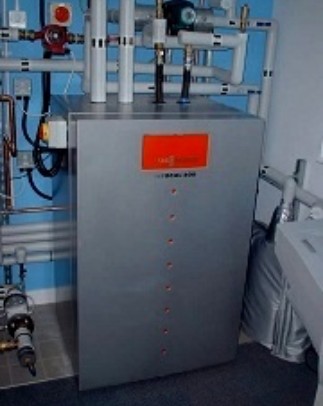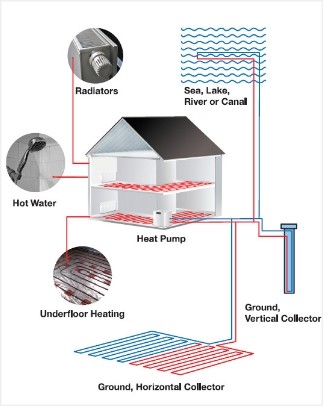How Ground Source Heat Pumps Work
Ground source heat pumps work by absorbing heat from the ground and transferring the heat into buildings – to heat the buildings without burning fossil fuels.

The heat pump itself is located in the building and works on the same principles as a domestic fridge: the heat pump in a fridge transfers heat out of the fridge and uses a heat exchanger to disperse the heat from a small radiator at the back of the fridge into the room.
A ground source heat pump absorbs heat from the ground – by circulating water though piping in the ground – and transfers the heat into the building by circulating hot water though radiators, or underfloor piping circuits.
The heat pump increases the temperature it receives from the ground before circulating it into the house. It does this by compressing refrigerant gases. When a
large volume of gas is compressed into a small space the heat energy in the gas becomes concentrated – the gas becomes very hot. The heat pump uses a heat
exchanger to transfer that heat to the heating circuit in the building.
After the high pressure gas has yielded up its heat, the pressure of the gas is released and it then becomes very cold. The heat pump uses a heat exchanger to transfer that cold to the ground loop circuit. As the cold water is circulated through the ground it absorbs heat from the surrounding ground and the cycle can begin again.


The natural temperature of the ground
The natural temperature of undisturbed ground in Britain is very close to 10°C at a depth below six metres. This is true both in summer and winter as heat moves only very slowly through the ground. However, if a ground source heat pump is absorbing heat from that ground then the temperature of the ground will fall.
The ground temperature will fall faster if large amounts of heat are being extracted from a small volume of ground. As the ground temperature falls the ground source heat pump becomes less efficient and the “Coefficient of Performance” (“CoP”) may fall well below the level of 4 that can be expected from a well-designed system.
The CoP of a heat pump is largely determined by the difference between the input temperature from the ground and the output temperature delivered to the building. As this gap increases the CoP of the heat pump installation falls.
How Ground Source Heat Pumps Work to save money
- Ground Source Heat Pumps save money
Heat pumps are much cheaper to run than direct electric heating systems. GSHPs
are cheaper to run than oil boilers and can be cheaper than runing gas boilers.
Because heat pumps can be fully automated they demand much less work than
biomass boilers – this also saves you money. Heat pumps save space. There are no
fuel storage requirements. - Heat pumps are safe
There is no combustion involved and no emission of potentially dangerous gases.
No flues are required. - GSHPs require less maintenance than combustion based heating systems
They also have a longer life than combustion boilers. The ground heat exchanger
element of a ground source heat pump installation has a design life of over 50
years. - Heat pumps save carbon emissions
Unlike burning oil, gas, LPG or biomass, a heat pump produces no carbon emissions on site (and no carbon emissions at all, if a renewable source of electricity is used to power them). - GSHPs are safe, silent, unobtrusive and out-of-sight
They require no planning permission. Heat pumps can also provide cooling in summer, as well as heating in winter.
Installation of Ground Source Heat Pumps
To get the full benefit of a GSHP installation you will need to employ someone with design and installation experience. A ground source heat pump may not perform well unless it is incorporated in a good design by someone who understands the needs of the building, the use to which the building is being put and the local geology.
A well installed ground source heat pump installation can provide sustainable energy over the whole life of a building.
For more information on installation of ground source heating from an experienced source please contact one of our members from our members directory.
Explore our Directory
Are you looking for a designer, installer, driller or consultant to carry out some works? Explore our member directly for help with your project.
Explore Directory
Become a Member
The GSHP Association is the focal point for business interests in the ground source heat pump industry.
We represent the ground source heating & cooling industry, promoting sustainable use of heat pump technology and engaging with government and other bodies to influence relevant policymaking on behalf of our members.

